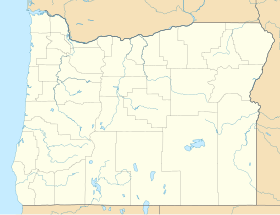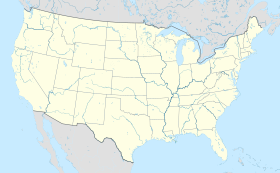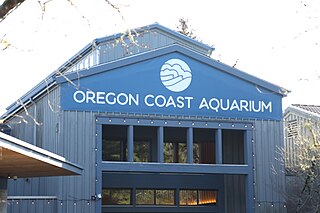
The Oregon Coast Aquarium is an aquarium in Newport in the U.S. state of Oregon. Opened in 1992, the facility sits on 23 acres (9.3 ha) along Yaquina Bay near the Pacific Ocean. The aquarium was home to Keiko, the orca who starred in the movie Free Willy, from January 7, 1996, until September 9, 1998, when he was shipped to Vestmannaeyjar, Iceland. USA Today considers the Oregon Coast Aquarium world-class and Coastal Living magazine ranks it among the top ten aquariums in North America.
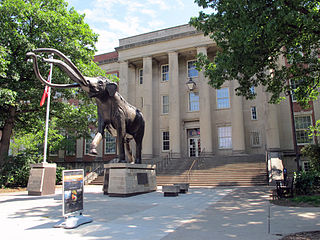
The University of Nebraska State Museum, also known as Morrill Hall, founded in 1871, is a natural history museum featuring Nebraska biodiversity, paleontology, and cultural diversity, located on the University of Nebraska–Lincoln City Campus near the corner of 14th and Vine Streets in Lincoln, Nebraska, United States. The museum houses Mueller Planetarium, a hands-on science discovery center, and the Elephant Hall, where visitors can see the world's largest articulated fossil mammoth among the collection of fossil elephants. Also featured are interactive paleontology exhibits, a dinosaur gallery, ancient life and evolution exhibits, wildlife dioramas, gems and minerals, American Indian and African exhibits, and a temporary exhibit gallery featuring rotating displays on diverse topics including photography, quilts and fine arts.

The Tamástslikt Cultural Institute is a museum and research institute located on the Umatilla Indian Reservation near Pendleton in eastern Oregon. It is the only Native American museum along the Oregon Trail. The institute is dedicated to the culture of the Cayuse, Umatilla, and Walla Walla tribes of Native Americans. The main permanent exhibition of the museum provides a history of the culture of three tribes, and of the reservation itself. The museum also has a second hall for temporary exhibitions of specific types of Native American art, craftwork, history, and folklore related to the tribes.

The Buffalo Bill Center of the West, formerly known as the Buffalo Bill Historical Center, is a complex of five museums and a research library featuring art and artifacts of the American West located in Cody, Wyoming. The five museums include the Buffalo Bill Museum, the Plains Indians Museum, the Whitney Western Art Museum, the Draper Natural History Museum, and the Cody Firearms Museum. Founded in 1917 to preserve the legacy and vision of Col. William F. "Buffalo Bill" Cody, the Buffalo Bill Center of the West is the oldest and most comprehensive museum complex of the West.

The Portland Art Museum (PAM) is an art museum in downtown Portland, Oregon, United States. The Portland Art Museum has 240,000 square feet, with more than 112,000 square feet of gallery space. The museum’s permanent collection has over 42,000 works of art. PAM features a center for Native American art, a center for Northwest art, a center for modern and contemporary art, permanent exhibitions of Asian art, and an outdoor public sculpture garden. The Northwest Film Center is also a component of Portland Art Museum.

The Denver Museum of Nature & Science is a municipal natural history and science museum in Denver, Colorado. It is a resource for informal science education in the Rocky Mountain region. A variety of exhibitions, programs, and activities help museum visitors learn about the natural history of Colorado, Earth, and the universe. The 716,000-square-foot (66,519 m2) building houses more than one million objects in its collections including natural history and anthropological materials, as well as archival and library resources.

The Royal Alberta Museum (RAM) is a museum of human and natural history in Downtown Edmonton, Alberta, Canada, located north of City Hall. The museum is the largest in western Canada with more than 7,600 square metres (82,000 sq ft) exhibition space and 38,900 square metres (419,000 sq ft) in total.

The Bruce Museum is a regionally based, world-class museum located in Greenwich, Connecticut with a multi-disciplinary collection and exhibition program bringing together art, science, and natural history. Accredited by the American Alliance of Museums, the museum hosts changing exhibitions of art, photography, natural history, science, history and culture, with more than a dozen changing exhibits each year. The Museum is dedicated to serving both local and global audiences, encompassing perspectives of artists and scientists from all around the world.

The Oregon Historical Society Museum is a history museum housed at the Oregon Historical Society in downtown Portland, Oregon, United States. The museum was created in 1898 and receives about 44,000 visitors annually.
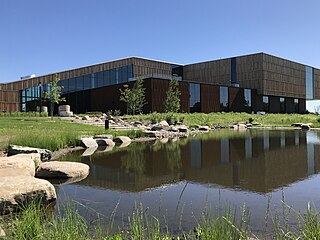
The Bell Museum, formerly known as the James Ford Bell Museum of Natural History, is located at the University of Minnesota. The museum's new location on the St. Paul campus opened in 2018. The Minnesota wildlife dioramas showcase animal specimens from around the world. The museum also houses the 120-seat digital Whitney and Elizabeth MacMillan Planetarium. The museum is part of the university's College of Food, Agricultural and Natural Resource Sciences. The museum's former location in Minneapolis is closed in January 2017.

The Arizona Museum of Natural History located in Mesa, Arizona, is the only natural history museum in the greater Phoenix area. It exhibits the natural and cultural history of the Southwestern United States.

Collier Memorial State Park is a state park in southern Oregon. The park is operated and maintained by the Oregon Parks and Recreation Department. It is located on U.S. Highway 97, approximately 30 miles (48 km) north of Klamath Falls and 105 miles (169 km) south of Bend. The park covers 146 acres (59 ha) along the Williamson River.
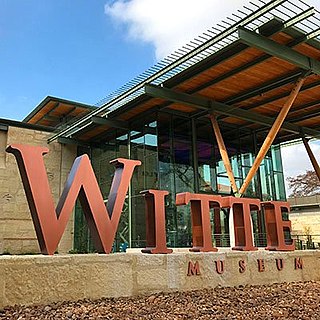
The Witte Museum was established in 1926 and is located in Brackenridge Park in San Antonio, Texas. It is dedicated to telling the stories of Texas, from prehistory to the present. The permanent collection features historic artifacts and photographs, Texas art, textiles, dinosaur bones, cave drawings, and Texas wildlife dioramas, in addition to nationally acclaimed traveling exhibits. Artwork in the collection includes sculpture by San Antonio-born Bonnie MacLeary.

The Rice Northwest Museum of Rocks and Minerals is a non-profit museum in Hillsboro, Oregon, United States. Located just north of the Sunset Highway on the northern edge of Hillsboro, the earth science museum is in the Portland metropolitan area. Opened in 1997, the museum's collections date to the 1930s with the museum housed in a home built to display the rock and mineral collections of the museum founders. The ranch-style home is listed on the National Register of Historic Places, the first of its kind listed in Oregon. In 2015 the museum became a Smithsonian Affiliate museum.

The Paul H. Jensen Arctic Museum was a museum focused on the culture and environment of the Arctic in Monmouth in the U.S. state of Oregon. Located on the campus of Western Oregon University (WOU), the museum opened in 1985 with 3,000 artifacts collected by its late founder and namesake. The museum housed 5,000 artifacts and had exhibits on the wildlife of the Arctic along with displays that demonstrate the culture of the Inuit and Eskimo peoples of Alaska. The museum was one of only two museums focused on life in the Arctic located in the lower 48 states, and the only one on the West Coast. In 2013, WOU announced that the Jensen Museum would close its doors and the collections would move to the University of Oregon Museum of Natural and Cultural History (MNCH) at the University of Oregon in Eugene, which also has substantial Arctic collections.
The California Living Museum is a zoo in Bakersfield, California. The primary focuses are plants and animals that are native to California, specifically Kern County.

The University of Michigan Museum of Natural History is a natural history museum of the University of Michigan in Ann Arbor, Michigan, United States.

The El Paso Museum of Archaeology presents information about the prehistory of the area surrounding El Paso, Texas. The museum is located in Wilderness Park, and is adjacent to the National Border Patrol Museum at the base of the Franklin Mountains, surrounded by Castner Range National Monument. It is located near several archaeological sites, including rock art in the Franklin Mountains and Mogollon pueblo sites. The museum attracts about 42,000 visitors every year.

Fossil Lake is a dry lakebed in the remote high desert country of northern Lake County in the U.S. state of Oregon. During the Pleistocene epoch, Fossil Lake and the surrounding basin were covered by an ancient lake. Numerous animals used the lake's resources. Over time, the remains of many of these animals became fossilized in the lake sediments. As a result, Fossil Lake has been an important site for fossil collection and scientific study for well over a century. Over the years, paleontologists have found the fossil remains of numerous mammals as well as bird and fish species there. Some of these fossils are 2 million years old.
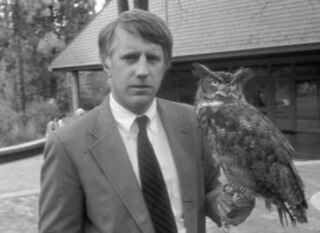
Donald M. Kerr was an American wildlife biologist and conservationist. He founded the High Desert Museum in Bend, Oregon. Kerr led the museum for sixteen years, helping it develop and expand to become one of Central Oregon's most popular tourist attractions. The museum’s Birds of Prey Center and a high desert conservation award are named in his honor.

